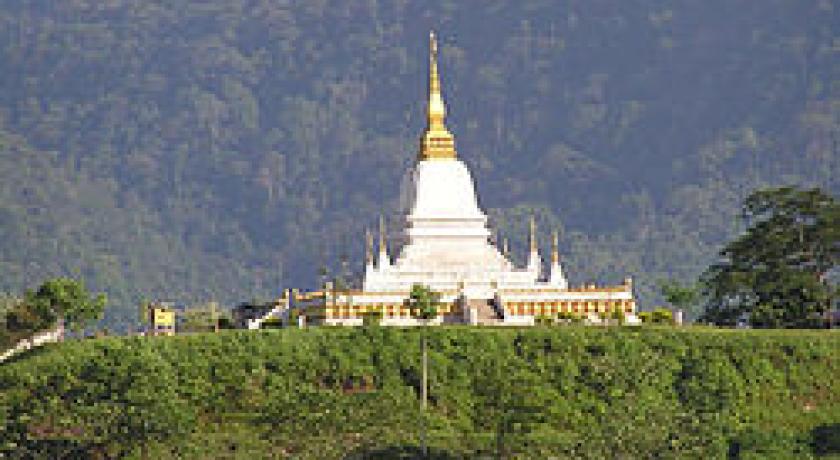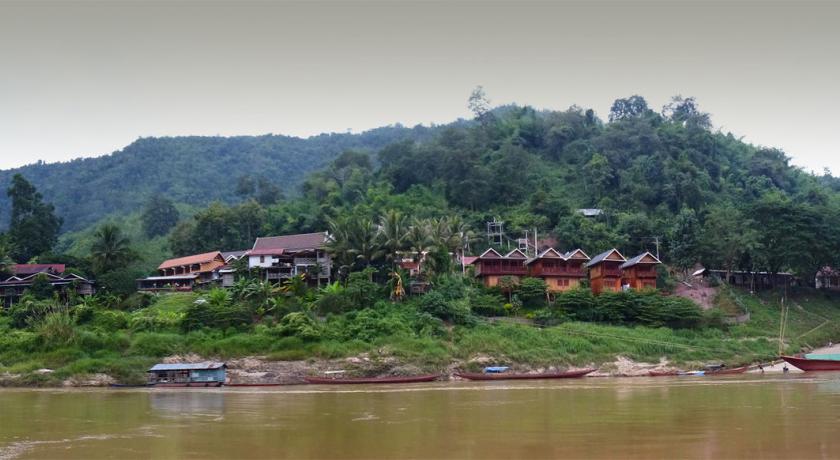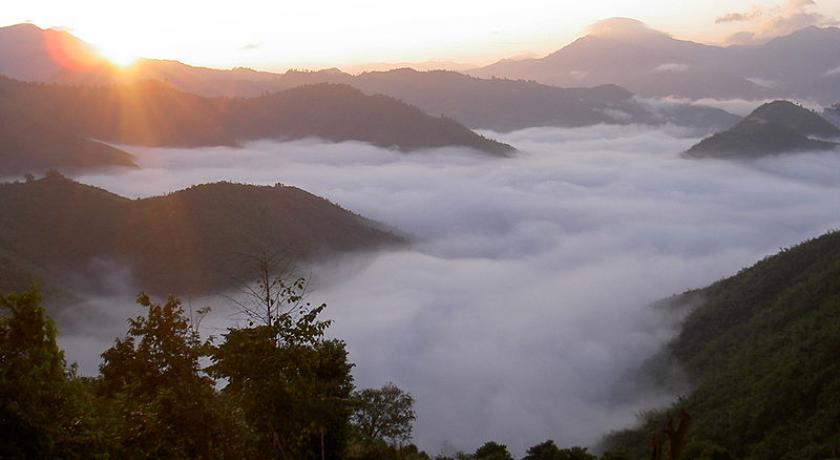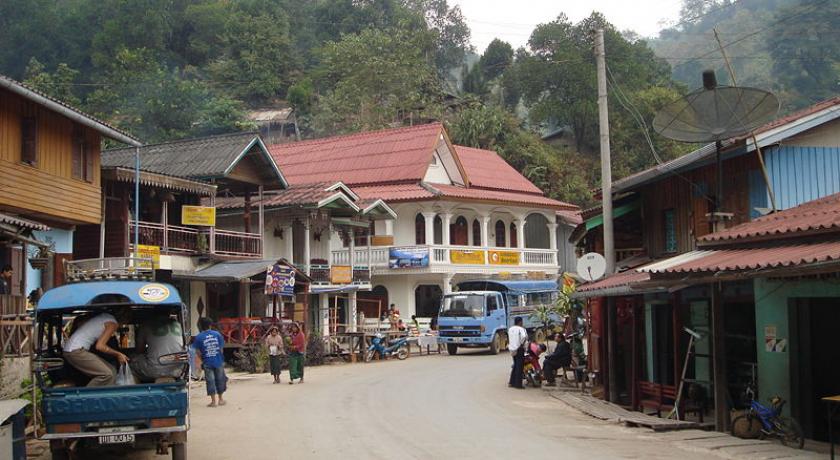Description
Oudomxay (alternates: Oudômxai or Moung Xai; Lao: ອຸດົມໄຊ) is a province of Laos, located in the northwest of the country. The province capital is Muang Xai.
Demographics
The population of the province according to the March 2005 census is 265,128.
The exact proportions of the approximately 14 different ethnic groups living in Oudomxay are still not precisely known. According to the province administration, the following estimations can be assumed; Khmu (among them Khmu Lu, Khmu Khong, Khmu Am, Khmu Bit) 60–80%, Lao Loum 25%, Hmong (among them Hmong Khao, Hmong Dam und Hmong lai) 15%. Minor ethnic groups living in the province include Akha, Phouthai (Thai Dam & Thai Khao), Phou Noy (Phou Xang, Phou Kongsat, Phou Nhot), Lao Houy (also “Lenten“), Phouan, Ly, Yang, Ikho and Ho.
Economy
Oudomxay has deposits of salt, bronze, zinc, antimony, brown coal, kaolin and iron deposits. Attempts to control poppy cultivation in the province have been made through the Narcotics Crop Control Project, formulated in the 1990s. The extremely limited accessibility of the mountain villages additionally impedes economic development of rural regions. Approximately 40,000 hectares of land are cultivated in Oudomxay, with rice being the main crop.
Subsistence agriculture
In Oudomxay province, most of the population still practices subsistence agriculture. Predominantly "slash-and-burn"-agriculture is used, often linked with growing mountain rice – 45% of rural villages in Oudomxay depend on swidden agriculture, due to the province's mountainous topography. This form of agriculture is very labour-intensive and takes up huge areas of land, as soils need a long time until their original productivity is recovered. Cropping rice using the wet-field paddy system is just possible in plain lowlands, which in Oudomxay are scarce. Both mountain rice grown at the mountain sides, as well as most of the few cultivable areas in the lowlands are merely irrigated by natural rainfalls. Very few rice fields in the lowlands have artificial irrigation systems. Besides rice, other important crops are corn, soybeans, fruits, vegetables, cassava (maniok), sugarcane, tobacco, cotton wool, tea and peanuts. In 2004, approximately 10,000 tons of sugarcane and 45,000 tons of corn were produced. Corn, onions, watermelons and tobacco are exported. In cooperation with international organisations, the government is working to increase production intensity proposing a sustainable usage of natural resources. Besides the use of land for agricultural purposes, approximately 40,000 hectares of land are forested or used as meadows. Life stock breeding, above all of water buffalos, pigs, cattle and chickens, is an important component for the livelihood of rural population. According to estimations of the IUCN, approximately 12% of Oudomxay forests are primary forests, 48% secondary forests. For the population, the forests are not only source of wood, but also contribute to family incomes providing fruits, herbs and meat. It is also common that Lao cultivable land is rented to Chinese, which then is tilled by Chinese migratory labourers.
History
According to local history books, the first people who settled in Oudomxay around the year 700 were "Khom" (also known as Khmu). About 1260, Lao Ly came from the region of Sipsongpanna in southern China and built a village called Ban Luang Cheng ("big village" or "big district") in the area of today's province capital Muang Xay. The former Lao Ly village is now part of Muang Xaya and is called Bang Cheng.
Ly culture, which was marked by Buddhism on the one hand and the old Khom traditions on the other hand, grew and became very influential on the region. Khom and Leu lived together and shared the same rice fields. To provide protection they erected fortifications between the villages of Na Sao and Na Lai. Around 1828, Hmong tribes coming from China began to settle in Oudomxay. The modern province was created in 1976, when it was split off from Luang Prabang. Around 1987 the capital of the province was moved from Ban Nahin to Muang Xay. In 1992, the districts Paktha and Pha Oudom were reassigned to Bokeo province.
Geography
Oudomxay Province, one of the provinces of Laos, covers an area of 15,370 square kilometers (5,930 sq mi). The province borders China to the north, Phongsali Province to the northeast, Luang Prabang Province to the east and southeast, Xaignabouli Province to the south and southwest, Bokeo Province to the west, and Luang Namtha Province to the northwest. In the northwest there is a 15 kilometers (9.3 mi) border with the autonomous area of Xishuangbanna of the People's Republic of China. Notable settlements include Muang Xay, Muang La, Pak Beng, Sen Say, Taxoum, Seneke, Sala Mok, Ban Na He, Ban Chomka, Ban Lao Phe, Ban Na Houang, Ban Lo Sa, Ban Lao Than, Ban Donkon, Ban Senlouang, Ban Napa, Ban Phoukeu, Ban Yamai, Ban Haiteu, Ban Kavang, Ban Kheun, Muang Houn, Ban Na Mao, Ban Tong, Ban Khmou, Ban Khokka, and Ban Tong.
The topography of Oudomxay is very mountainous. Altitudes vary between 300–1,800 meters (980–5,910 ft) above sea level. Approximately 60 rivers flow through Oudomxay Province, as for example Nam Phak, Nam Sae, Nam Beng, Nam Kor and Nam Nga. The Nam Kor River flows through the province capital Muang Xay. Oudomxay Province has a moderate monsoon climate. The yearly amount of rain is about 1,900–2,600 millimeters (75–102 in). Temperatures in February and March average between 18 and 19 °C, from April to May temperatures climb over 31 °C. Due to high altitudes there are more variations in temperature during the year and a colder dry season in northern Laos as in the rest of the country.
Protected areas
The Upper Lao Mekong Important Bird Area (IBA) is 10,980 hectare in size. It spans the provinces of Oudomxai, Bokeo, and Sainyabuli. The altitude is 300–400 meters (980–1,310 ft) above sea level. Noted topography includes river channel, exposed beds, sandbars, sand and gravel bars, islands, rocky outcrops, bush land, and braided streams.
Recorded Avifauna.
Black-bellied Tern Sterna acuticauda, Great Cormorant Phalacrocorax carbo, Grey-headed Lapwing V. cinereus, Jerdon's Bushchat Saxicola jerdoni, Plain Martin Riparia paludicola, River Lapwing Vanellus duvaucelii, Small Pratincole Glareola lactea, and Swan Goose Anser cygnoides .
Vegetation in Oudomxay is rich by virtue of the monsoon climate. Several kinds of bamboo and a broad range of plants (for example orchids) are found in the region. Also hardwoods like teak and mahogany trees grow in Oudomxay and are important sources of income for the population.
Tourism
For some years, efforts have been taken to support tourism in Oudomxay, which is considered as a chance to minimize poverty in the population. A tourism office has operated in Muang Xay since 1997, supported by German Development Service (DED) since 2005. The support of DED aims to raise the incomes especially of the rural population and small-scale enterprises by tourism and thereby protect natural resources. In August 2007 the tourism office was upgraded to a “Provincial Tourism Department”. Due to Oudomxay’s location as the most important traffic junction in northern Laos (the only road from Luang Prabang up north crosses Oudomxay); in the past few years the province was mainly visited by foreigners on the journey through. The average length of stay was low. According to the (Statistical Report on Tourism in Laos 2008) by the (Lao National Tourism Administration), the number of tourists has increased from approximately 18,600 to 102,000 from 2001 to 2008. According to the statistic, approximately 17% of all 1.7 million tourists visiting Laos in 2008 came to Oudomxay as well. Oudomxay has eight hotels and approximately 52 guesthouses, most of them located in the province capital Muang Xay and the riverine traffic junction Pak Beng. Bad infrastructural conditions impede an optimal exhaustion of touristic potential in Oudomxay province. Trekking tours to villages of ethnic minorities are not impacted by infrastructural limitations.
Landmarks & Attractions
There are many landmarks in the province and some of the prominent ones are the following.
- Muang La is an important Buddhist pilgrimage for Theravada Buddhists in the province. Saymoungkhoune Rattana Stupa located here has a highly revered Buddha image, which is 400 years old and is reported to have supernatural powers.
- Ban Chom Ong is an outstandingly beautiful village of about 500 people of the ethnic group Khmu. It is starting point to the biggest cave in Northern Laos. Surrounded by paddy rice fields, locked by mountains, it is still largely untouched by modern influences. There is no electricity nor mobile phone signal in the village, but as a compensation you'll get the chance to observe authentic village life as for example handicraft production - most of the people still wear their traditional Khmu clothes. For their scarce visitors, the villagers have a basic bamboo guesthouse with an outside Lao style bathroom (15,000 kip per night), and they will be happy to cook meals for you (10,000-20,000 kip per person). There is very little English spoken in the village so prepare for communication problems or take a translator with you. The Tourism Office offers 1-day, 2-day and 3-day guided tours to village and cave, including transportation. On 1-day tour price for 1 person is 1,400,000 kip, for group of 8 persons 360,000 kip per person. If you decide to go on your own, you can rent a motorbike or a car to go on the (very difficult) 40 km dirt road from Muang Xay to the village.
- Chom Ong Cave, the longest cave in Laos, is located in Ban Chom Ong, 45 km to the northwest of Oudomxay town and is the biggest known cave in northern Laos. The cave was explored by a team of cave researchers during 2009, 2010 and 2011 and reported to be 18.4 km long and considered as the second longest in Laos and 9th longest in South East Asia. The average dimensions of the cave are 20–25 m in width and 20–30 m in height. It has two passages, one is a stream and the other has fossils and both connect to a large hall which is 100 m long, 30 m wide and of varying height of 30–50 m up to the roof. It has a stream inlet in the north and the stream outflows in the southern end. The natural attraction is accessible in a 50 minutes’ walk from the village "Ban Chom Ong".
- Nam Heeng. If you're very adventurous, it is also possible to reach Ban Chom Ong going to a village called Ban Nam Heeng first. The village itself is not particularly interesting, but from it is a 16km walk to Chom Ong village, where the cave is located. So called "Packing" cars leave from a public transport station near the normal bus station, the cost kip to Nam Heeng is about 35,000 kip. The challenging hike from Nam Heeng to Chom Ong takes approximately 5 hours. It is advisable to ask the villagers for directions to Ban Chom Ong.
- Nam Kad Waterfall and Pristine Forest. While visiting Nam Kad Waterfall you can not only swim in the ice cold basin under the waterfall but also see one of the most untouched and beautiful pristine forests in Laos. Rent a motorbike and follow the sign which says "Nam Kad". At a village called "Ban Faen", turn right, and then just follow the road. You'll have to cross the winding river 5 or 6 times, which might be slightly difficult in the rainy season. When the road ends, it is a 30 minutes’ walk to the waterfall in a wonderful jungle atmosphere. The distance from Muang Xay to Nam Kad is 23 km.
During the Indochina war, people of the village, who had till then kept the location of the cave a secret, had to use the cave as bomb shelter, and they thought that their prayers to Buddha had helped to protect them from the bombings. Hence, they named the cave as “Phachao Khamtan” or “Khamtan Buddha” Cave where 'Phachao' means "Buddha" and 'Khamtan' means "Valuable Protective Shield".
In Town
Route 13, the country’s most important highway, leads right through town and acts as the main street and throughway.
Oudomxay Museum. In the Museum there are just few items to look at, the view you have from the top of "Phou Sebey" mountain is very nice. Go there early in the morning, when the sun is still low - you may watch the town centre waking up and enjoy the morning light as it starts caressing the roofs before the day gets too hot.
Phuuthat-Stupa. Just opposite of the stairs to the museum there are similar stairs to climb, leading to an 18 meters high Stupa. The stupa was built in 14th century to allow all people of the region to come together, to celebrate religious festivals. When under French control, the area of the stupa was made into a war camp. During the first Vietnamese war the stupa was destroyed and only bricks were left. Reconstruction started in 1994 and was completed 3 years later. Religious celebrations are held at the stupa during the day of each full. Since April 2010 there is also a golden, 15 meter-high Buddha statue watching over Oudomxay from the top of Phou That, seeming to spur Oudomxay people to new religiousness. Enjoy the view over the town and see the stupa and Buddha shining in the sunset. The monks at the nearby temple are always happy to practice their English with foreigners.
Do
The local Provincial Tourist Office (in Oudomxay City, or Muang Xay) has been offering since November 2006 some very nice hiking including nightstays in khamu family houses (not guest houses, as in other more touristy hike places, which makes the experience very special and intimate). Although not as colourful as other ethnic groups of Laos, the khamu people are very nice and happy to have foreigners visiting their villages.
Culture
The Baci festival was started even before Buddhism made inroads into Laos, as an animist ritual used to celebrate important events and occasions, like births and marriages and also entering the monkhood, departing, returning, beginning a new year, and welcoming or bidding etc. It is particularly special for ethnic groups of the mountainous region of northern Laos such as Oudomxay Province, though it is now celebrated throughout Laos as a national festival and also in neighbouring Thailand. It’s a traditional cult festival in which after offering prayers to Buddha, in a formal gathering people tie a white thread (symbolically representing purity) or string on the wrist of their opposites wishing for their well being, ward off ill luck and bring them good luck. The ceremony is held as a part of marriage festival or any auspicious occasion in the family when family members get together. The thread can be taken off only three days after its tying.
This practice is linked to the ancient belief that Baci is invoked religiously to synchronise the effects of 32 organs of human body considered as kwan (KWA-ang) or spirits or the “components of the soul.” Its observance to establish as social and family bond to maintain “balance and harmony to the individual and community, is done in its original format in Laos, as a substantiation of human existence.”
Banking & Shopping
The Thai Ly Handicraft Shop opposite the airport street has some attractive traditional fabrics, bags and clothes.
There are three banks and one post office offering change for cash and travellers' cheques, BCEL , about 1 km north of the bus station change travellers cheques for 3% commission with a US$3 minimum. It might be worth checking Lao Development Bank.
BCEL provides three ATMs, accepting international cards (BCEL charges 20,000 kip, be aware of charges of your own bank). Two are located by the bank itself, and a third is located 500m away over the bridge. There's a maximum of 700,000 kip per transaction.
Luxay Market
Luxay market is the market building located opposite the Tourism Office. In this market you can find all sorts of products. Upstairs is the clothing and shoes section. Get your daily necessity stuff at the market. The market closes at 5 pm.
Chinese Market
Around Luxay Market Chinese clothing- food- and house ware shops can be found. In contrast to the Lao shops, most of the Chinese market shops are open until late at night.
Food Markets
Go for a stroll there and be stunned by the great range of perceptions you will get: Rare animals are offered to eat, unknown smells fill the air and you will get to know the real everyday life of people of the province.
Oudomxay has three fresh food markets: Tin market, Nonmengda Market and Phoukhaiw Market. All these markets are an excellent place to discover the variety of unique foods that Oudomxay has to offer. Oudomxay has many food items and forest products that are either not available or in scarce supply in other parts of the country. The markets are open every day however they are particularly colourful on Saturday and Sunday afternoon. At all the markets you will find products of different ethnic groups. The markets close at 6pm.
Restaurants
- Souphailin's Restaurant offers a broad range of fresh Lao, European and vegetarian dishes. On the main road across the street are some women selling barbecue chicken and rice. Chicken 5,000kip, sausage 1,000-5,000kip. Excellent fried vegetarian spring rolls.
- The "Siso Bakery" (on the street opposite the bus station) offers great sandwiches, homemade breads, cookies and - people say - the best hamburgers ("Oudomburger") in whole Laos (if you want a veggie burger with egg instead of meat just order an "Oudom-Khai").
- Muang Neua Restaurant in the town center offers international dishes and cocktails you can get in the nice garden atmosphere, prices are a bit higher than usual and portions a bit smaller.
- Steamboat restaurant offering good Lao's style Korean BBQ. just about 1 km from the bus station (road to Luang Namtha).
On the Tourism Office's town map all restaurants are shown.
Sleep
There are a number of decent guesthouses in town. Basic rooms with showers and hot water. A few minutes from the bus station are places including TV and en suite bathrooms. Be sure to bargain if they claim no TV or hot water.
- Vivanh Guesthouse is just over the central bridge near the market building and has very nice and clean rooms. 60,000 kip. Has wifi.
- Vila Keo Seum Sack has beautiful light double rooms, including TV and air-con, for 100,000 kip per night.
- Lithavixay Guesthouse offers, besides good rooms, free wireless internet access, bicycle rental and flight ticket bookings. Doubles 60,000-80,000. Update April 2016: the guesthouse no longer offers bikes for rent.
- Phanmixay Guesthouse - inside the bus station compound. Has clean and nice rooms. US$4 for a double room with shower, hot water and cable TV.
- Dokbouadeng Guesthouse - left side of the main road a little bit in town. Has clean, naturally cool rooms with bathroom and hot water, free WiFi and water and soft beds! Prices are a bit higher but off season it's easy bargaining with the very nice lady who runs the place.
- Vilavong G.H, ☎ 212503. Small, nice guest house. Friendly owners.
Get around (Moung Xai)
Most of the town's highlights are within walking distance from one another and the free maps offered by the Provincial Tourism Office offer great directions. The Tourism Office is located on the main street, just after the bridge over the Kor River, on the left side as you walk from the bus station (walking distance approx. 1 km). They also offer bikes (50,000 kip/day) and motorcycles (100,000 kip/day) for hire. There are other places in town where you can rent motorbikes, just watch out for the signs.
Transport
Oudomsay Airport (or Oudomxay Airport) is an airport in Muang Xay, Laos (IATA: ODY, ICAO: VLOS). Lao Airlines ; Destination Vientiane. This airport is one of the few we have come across which you can walk to – it is virtually in the town centre.
By Bus
There are two stations in Oudomxay, the Northern bus station and the Southern one. We advise you to buy your bus tickets 1 hour before departure time.
Northern bus terminal (busses to/from north of Udomxai) is in the center of the town. Southern bus station (busses to/from south of Udomxai) is 5 km from city center.
- Buses from/to Luang Namtha takes up to 4 hours. Departures from Muang Xay are at 08:30, 11:30 and 15:00.
- Buses from/to Nong Khiaw takes up to 4.5 hours. Departure from Nong Khiaw are at 11:00.
- Buses from/to Luang Prabang leaves three times a day and take about 5 hours.
- Bus from/to Pak Beng takes up to 4 hours. Departure at 12:00 from Pak Beng Bus Station at the end of the main road.
- Bus to Kunming (for sleeping bus) takes up to 15 hours. Departure at 12:00.
Further daily buses come from/go to Vientiane, Phongsali, Muang Khua and Bokeo. Some buses also go to China.
Address
Oudomxay Province
Laos
Lat: 20.492193222 - Lng: 101.889175415







